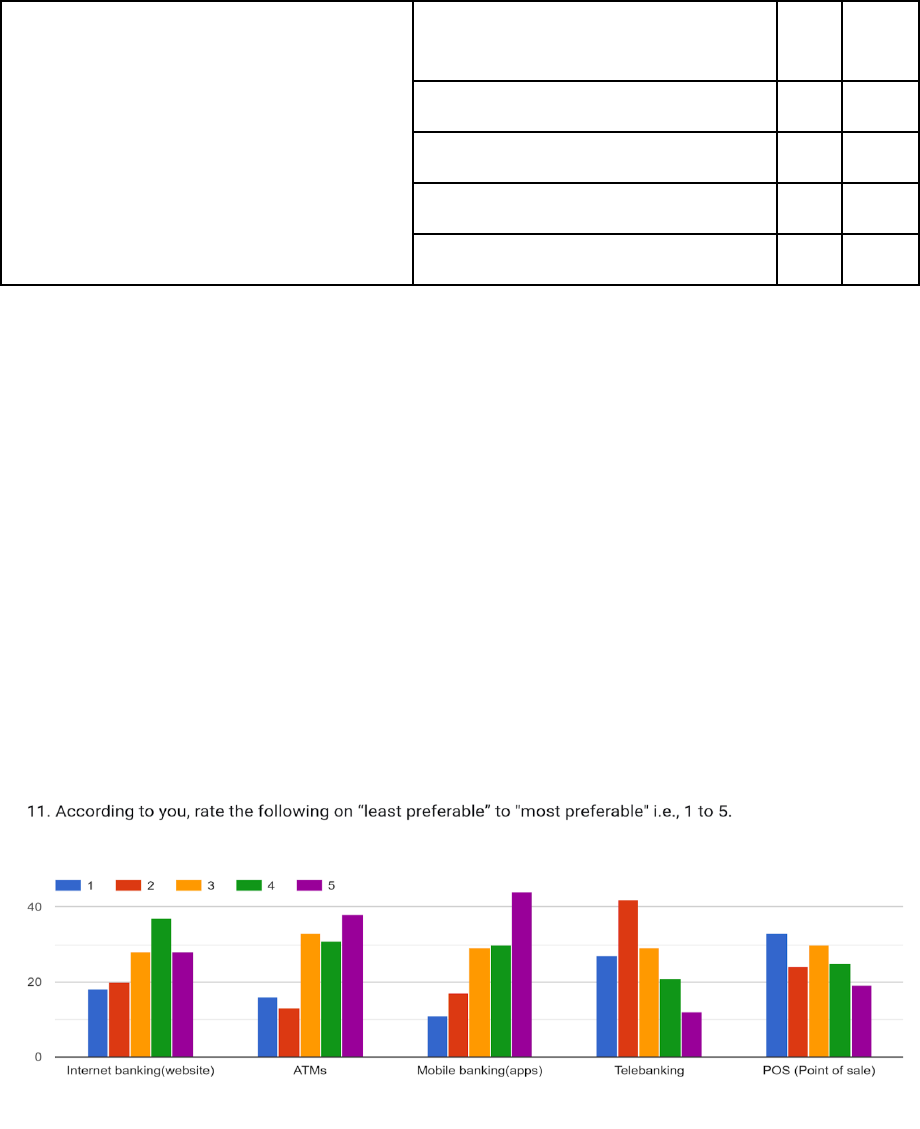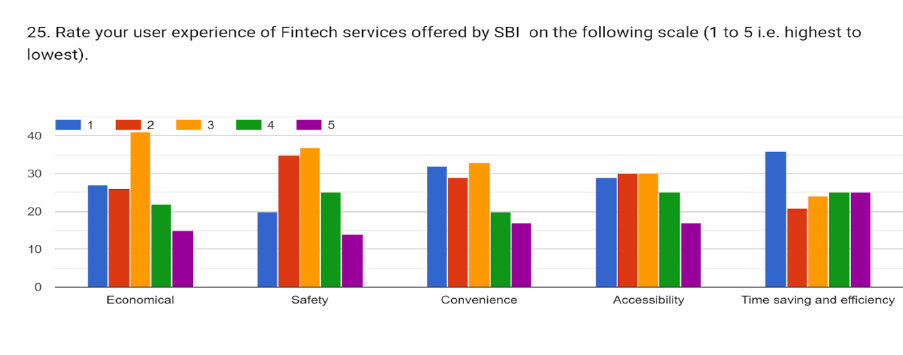
Business Studies (UGC - CARE Listed Journal Group I, ISSN 0970-9657)
Volume – XLV, No. 1, January, 2024
108
Fintech Adoption in Banking Sector: An Empirical Study
Dr. Jinti Sharma
Assistant Professor
School of Commerce and Business Management,
Pragjyotishpur University
Email: jintisharma21@gmail.com
Bipasha Sharma
Assistant Professor
Faculty of Commerce and Management
Assam Down Town University
Email: bipashasharma007@gmail.com
Abstract
India has evolved as one of the fastest growing economies of the world, especially after the prolonged macro-economic
factor of Covid-19 which stimulated India to take up the Umbrella scheme of Aatma-Nirbhar Bharat i.e. Self-Reliant
India. This gave a boost to India’s quest to pave more towards technologies and become a Tech advanced country
turning it into a global fin-tech superpower. Furthermore, India has launched varied schemes and initiatives, particularly
in North-eastern India.
Guwahati, a city of Assam has been able to attract modalities from many parts of India and the world in its place by
being an epitome of emerging India. This paper throws a light on the trends of the technologies inculcated in the city
and the awareness and experiences relating to the adoption of such fintech services. The paper examines the stages of
fintech development and instillation in the city and the pace of fintech adoption by the consumers in the banking sector.
The methodology includes preparation of structured questionnaires for data collection from 130 SBI customers in an
attempt to study their experiences of fintech solutions offered by banks. The findings include the quality of fintech
services offered, preferences, experiences and challenges faced in usage of services from consumers’ point of view.
Keywords: Fintech, Fintech Unicorns, Fintech Adoption, Banking Sector.
1. Introduction
intech mostly refers to start-up businesses that combine technology with finance and offer specialised
versions of the existing products and services of established financial institutions like banks, asset
management firms, and insurance companies. (Karthika, 2022).
Fintech can be generally explained as
digitization of financial services within the finance industry or it can be stated as a technology that is designed
to provide financial services in an easy manner. According to the Financial Stability Board (FSB), of the
BIS, “Fintech is technologically enabled financial innovation that could result in new business models,
applications, processes or products with an associated material effect on financial markets and institutions
and the provision of financial services”. This definition aims at encompassing the wide variety of innovations
in financial services enabled by technologies, regardless the type, size and regulatory status of the innovative
firm. (Goyal, 2022).
F

Jinti Sharma and Bipasha Sharma
109
Evolution of Fintech
The use of technology in finance is not new to the industry. Fintech development started in between 1865-
1966 when transatlantic cable was set up. In 1918, Fedwire invented Electronic Fund Transfers using
telegraph and Morse code which marked the beginning of the money's conversion to digital form. In 1950,
the first universal credit card was introduced by the Diners’ Club to make cashless payments followed by the
introduction of Barclay’s first ATM in 1967. In 1970, computers became an integral part in the back offices
which gradually shifted to middle and front offices of the financial institutions. Later to modernise the
bidding procedure, NASDAQ was established as the first electronic stock market in 1971. In 1973, Society
for Worldwide Interbank Financial Telecommunications (SWIFT) was used by financial organisations to
transfer instructions and information securely using a set of codes (Fayen, 2023). During 1980s, digital
technology companies emerged to serve financial institutions that included core banking system providers
like Fidelity National Information Services (FIS) and Fiserv as well as payments networks like Mastercard.
The fintech sector witnessed a major shift after the financial crisis of 2008, when new technologies like
Bitcoin and P2P were introduced followed by the blockchain model. (Ramakrsihnan, 2022).
Why Fintech?
Digital technology has been reshaping financial services by eliminating many barriers in delivery of services.
The internet and mobile technology have connected the consumers with the financial service providers with
reduced the cost of information transfer and remote interactions. Minimum access to the services at least
with a smartphone is available to billions of individuals across the globe. This has encouraged the financial
service providers like banks to engage in digital technology making them more approachable and accessible
online than through traditional methods. In comparison to traditional services, fintech generates fast revenue,
delivers quality service and reduces expenses that reconfigure the financial industry. (Huparikar, 2022)
Fintech – SWOT Analysis
Strengths
Weaknesses
Opportunities
Threats
▪ Innovation in the
banking sector with
dynamic and pervasive
banking models
▪ Resistance to
shift to modern
banking practices
▪ De-risking solutions
▪ Lack of customer
loyalty
▪ Contribution to the
growing Research and
Development
▪ Lack of
awareness among
consumers
▪ More penetration
▪ Lack of effective
regulations
▪ Increased flexibility and
decreased cost
▪ Lack of
infrastructure
▪ New partnerships
between traditional
and fintech sector
▪ Fast changing
and obsolete
technologies
▪ Effective risk
management with
provision of customer-
friendly solutions
▪ Lack of
consumers’ trust
▪ Financial inclusion
▪ Data Breach
▪ Penetration and serving
of under-served
customers
▪ Financial risk
▪ Sustainability
▪ Cyber frauds
Source: Researcher’s analysis

Business Studies (UGC - CARE Listed Journal Group I, ISSN 0970-9657)
Volume – XLV, No. 1, January, 2024
110
Fintech Start-ups in India
India is a hub of fintech markets in the world. The drive of financial inclusion and Digital India by the
Government has paved the way for fintech companies to grow and become top fintech unicorns. Turning the
entire economy completely cashless is yet a challenge but with the rapid use of smartphones, people have
resorted to cashless transactions through digital wallets marking the first step in fintech adoption.
There are around 9000 fintech startups in India with 21 fintech unicorns. Some of the major fintech
companies of India are discussed below:
BharatPe: BharatPe headquartered in Delhi was established in the year 2018. It provides QR code-based
payment solutions for consumers and businesses. Users can use it to pay for groceries, restaurants, cabs,
salons, mobile businesses and energy bills, among other things. It is an app-based platform that allows
merchants to take payments from customers.
CAMS: Computer Age Management Services (CAMS) established in 1988 in Chennai, is an online platform
focused on mutual fund investments that allows users to invest in multiple public market securities through
app-based platforms. It provides tools for managing portfolios, alerts & news updates to assist in developing
investment strategies. App can be accessed on iOS and Android devices.
CRED: CRED was established in 2018 in Bangaluru and serves in the B2C space in the FinTech market
segments. It supports managing different credit cards, real-time monitoring of credit scores, and the use of
calculators for home loans, EMIs, PPFs and other financial products.
Lendingkart: Lendingkart, established in the year 2014, Ahmedabad, is an online lending platform providing
business loans that offers loans such as working capital loans, SME loans and business loans for women.
Niyo: Niyo Key Metrics, established in 2015 in Bangaluru is an online platform for wealth management and
offers a savings and investments platform. It allows users to make investments in the financial market, offers
in-built Robo-advisory, mutual fund management, goal-based advisory and a banking platform for business.
Paytm: Established in 2009, Noida, Paytm is an app-based wallet for individuals and businesses. It provides
a web-based and mobile-based platform for mobile recharge, money transfer, bill payments, travel bookings,
hotel and ticket booking, booking cylinders, gold purchases and donations. It offers banking services, credit
cards, loans, and investment platforms for insurance, mutual funds, and more.
PhonePe: PhonePe, established in 2012 with headquarters in Bangaluru, serves as a card-linked wallet
solution for consumers and businesses and offers UPI-based options for bill splitting, online shopping, paying
postpaid and utility bills, mobile and DTH recharging, money transfers, online payments at retail shops,
paying mobile and DTH bills, checking account balances and other allied services.
Pine Labs: Pine labs is a fintech unicorn established in the year 1998, headquartered in Noida and serves in
the B2B, SaaS space in the Retail, Fintech market segments. Pine Labs provides payment solutions for
businesses and merchants, offers hardware and software-based payment terminals, point-of-sale financing
and working capital loans.
Policybazaar: Policybazaar, found in the year 2008 in Gurgaon, is an app-based comparison platform for
life and non-life insurances. It offers quotes for life insurance, health insurance, auto insurance, health
insurance, retirement plans, travel insurance, provides claims processing and policy renewal services and
also offers quotes for different investment plans.
Razorpay: Razorpay, located in Bangaluru was set up in 2013 and serves in the B2B, SaaS space in the
Retail, Fintech market segments as a Developer of payment processing solutions for businesses. It offers

Jinti Sharma and Bipasha Sharma
111
solutions such as payment gateways and link-based payment solutions for accelerating and automating
banking operations, working capital loans and corporate credit cards.
Some of the top fintech companies of India in various fields are-
Areas of Fintech
Fintech Companies
Investment Tech
Zerodha
Groww
Smallcase
Dezerv
Scripbox
Upstox
Insurance Tech
Policybazaar
Paytm
insurance
Insurity
Acko
Digit
Nova
Benefits
Neobanking
Jupiter
Fi
Open
Zolve
Chqbook.com
Akudo
Lending Tech
Capital
Float
Leap
Finance
Zest
Cred
Avenue
Kredit Bee
Uni
Fintech Saas
(Software apps)
Khata Book
Unbound
Charge
Bee
Pay
Mate
Zeni
Safexpay
Cryptocurrencies
CoinDCX
Zeb Pay
Unocoin
Bitbns
Coinswitch
Kuber
Wazirx
Source: https://digest.myhq.in/fintech-startups-in-india/
Fintech in Banking Sector
Fintech solutions in banking sector are offered through various channels. The SBI is a pioneer in offering
different customer tailored fintech services to its customers. Some common fintech services offered by SBI
are YONO SBI, YONO LITE, BHIM SBI Pay, SBI Quick, SBI Secure OTP, SBI e-Pay, YONO Business
and SBI Anywhere. The SBI offers these services through various channels like Internet banking (website),
ATMs, Mobile banking (apps), telebanking and POS (point of sales).
Some of the new fintech products offered by SBI are discussed below-
• State Bank Buddy: The mobile wallet for smartphones from State Bank of India is called State Bank
Buddy. It is a prepaid, semi-closed wallet that enables anytime, anywhere money transfers to bank
accounts and wallet users. The State Bank of India (SBI) launched an e-wallet called SBI Buddy in
August 2016 to encourage citizens to use cashless transactions. SBI Buddy does not require an SBI
account.
• State Bank Scribe: SBI offers this service to assist clients who are blind or visually impaired with
accessing financial services by providing them with scribes which help them complete different
banking activities. It helps in completing forms, reviewing papers, performing transactions and other
crucial duties.
• SBI Digi Voucher: The State Bank of India has developed a new green programme that makes it
simple to fill out coupons on smartphones. Access to numerous challans, transactions slips, and forms
is made possible via SBI Digi Voucher. People can save money by pre-completing transaction
paperwork online so they can have immediate access to the bank teller counter. One may check the
history of their digital coupons using the SBI Digi Voucher app.
• SBI Mingle: The bank's effort to integrate social media with banking is called SBI Mingle. Customers
of SBI may use this special software to access a variety of financial services through the bank's
Facebook page and Twitter account. The SBI Mingle app for smartphones is available to all SBI

Business Studies (UGC - CARE Listed Journal Group I, ISSN 0970-9657)
Volume – XLV, No. 1, January, 2024
112
customers. Once they have enrolled, they may use of a variety of services, including balance inquiries,
money transfers, mini statements, etc., especially with their Facebook and Twitter connections.
Fintech Adoption by Consumers
One of the key factors influencing fintech adoption behaviour is information quality. (Aggarwal, 2023). It is
important to consider how demographic aspects like gender, age, education, and income affect the decision
to use fintech. (Dhanalaxmi, 2022). The people's perceptions about digital payment methods have a big
influence on how they decide to pay. There are several situations when digital payments might not be
accepted, leaving only cash payments as an alternative. To identify the steps involved in the use of financial
technology in the financial services sector, a key component of users' intentions to adopt Fintech is customer
trust. Customers feel that an online company with a high reputation might adopt safe encryption technology
and assurances whenever there is a disagreement, which decreases the sense of danger while utilising Fintech.
(Peong, 2021). Also, the connections between various demographic characteristics, the acceptance of fintech
services, and the perception, usage patterns and barriers that bank customers must be considered in order to
use fintech services. (Roy, 2021). Everyone who lives in the country now has access to a national digital
biometric identification, which effectively gives them full access to the financial system. Retail consumers
and small-scale transactions now operate more efficient with the establishment of a real-time payment system
platform. The structure of the Indian payment system undermines the economic case for separate commercial
payment systems by offering affordable and immediate payment services to regular individuals. (D’Silva,
2019).
2. Background of the Study
Banks have undergone several reforms in the past years to overcome various challenges in the sector.
Evolution of fintech has posed another threat to the traditional banking services which compelled a lot of
banks to adopt fintech services to retain customers. However, the customers of the banks are not yet familiar
with the concept of fintech and the services available under it. Here the study aims to bridge the gap between
adoption of fintech by banks and its acceptance by the customers. (Savitha, 2022).
3. Significance of the Study
Indian Banks have undergone numerous reforms over the years comprising nationalisation, liberalisation,
globalisation, privatisation and digitalization. With the changing market dynamics and preference of
customers, banks have had a challenging phase to meet the expectations of customers and retain them.
(Aggarwal, 2023) In the continuous efforts of banks to include the unbankable masses in its ambit, tap the
potential segments, mitigating risks and countering various challenges, technology has been playing a
catalytic role. In this context, fintech has gained momentum in recent years in expanding the banking services
beyond physical barriers. The present study explores the role of fintech in the banking sector and also
examines factors behind the adoption of fintech services of SBI by its customers.
4. Objectives of the Study
• To examine the factors behind adoption of Fintech services by customers of SBI.
• To study the awareness and user experience of Fintech services offered by SBI.
• To find out the challenges that arise for SBI customers in using Fintech Services.

Jinti Sharma and Bipasha Sharma
113
5. Limitation of the Study
• Due to time constraint non probabilistic convenience sampling has been adopted for the study which
would not cover all the areas of Guwahati.
• Only SBI has been taken for the study which would not reflect the rate of adoption of Fintech services
by all commercial banks.
6. Methodology
Sample Size- In order to know the experience of customers of banks as users of Fintech services, a total of
130 customers of SBI from Guwahati have been selected for the study.
Sampling technique- To determine the sample size, the convenience sampling technique has been adopted
for the study.
Source of data- The primary data have been collected through structured questionnaires distributed among
the customers of SBI. The secondary data sources include research papers, articles from newspapers and
journals and official websites.
Technique of data analysis- Data is analysed using chi-square test and percentage method. To calculate p-
value in the chi square test, Chi Square calculator has been used.
Social Implications- The study focuses on examining the awareness and experience of the citizens of
Guwahati towards adoption of Fintech services by banks. The outcome of the study shall help to know the
pace of Fintech adoption by the customers of banks and fill the gap between the services offered by banks
and those received by customers.
7. Data Analysis
Profile of Respondents
A total of 130 respondents have been interviewed for the study through a structured questionnaire and data
have been collected from customers of SBI. A brief description about the profile of respondents is given
below-
Around 60% of the respondents are male users of fintech services in comparison to female users of 40%. The
young generation belonging to the age group of 18 to 28 years have shown interest in using fintech services
with approximately 42%, compared to other age groups. In-service employees are seen to be the highest
users of SBI fintech services followed by students with 37.2%. The respondents who are post graduates i.e.
50% are seen to use fintech services followed by 42% graduates.
Generally, the age, occupation and education of respondents play an important role in determining the
adaptability towards new technology. In this context, the relationships between age, gender, occupation and
education of respondents and adoption of such services can be traced and the following hypotheses have
been formed (Table 1).
Table 1: Profile of Respondents
GENDER
Male
77
59.7%
Female
53
40.3%
AGE GROUP
18 to 28 years
75
57.4%

Business Studies (UGC - CARE Listed Journal Group I, ISSN 0970-9657)
Volume – XLV, No. 1, January, 2024
114
29 to 39 years
37
28.7%
40 to 59 years
11
8.5%
60 and above
7
5.4%
OCCUPATION
Student
49
37.2%
Salaried
54
41.9%
Start up/ business owner
04
3.1%
Professional
13
10.1%
Unemployed
05
3.9%
Retired
05
3.9%
QUALIFICATION
HS
10
7.6%
Graduate
55
42.3%
Post Graduate
65
50%
Source: Field survey
Age and Adoption of Fintech Services
H
0
: There is no association between age and adoption of fintech services.
H
1
: There is an association between age and adoption of fintech services.
While examining the association between age and adoption of Fintech services, it is found that the age group
of 18 to 28 years are the highest users followed by 29 to 39 years. However, the other age groups are of the
opinion that they prefer to use the services with precautions, rather than using without knowing the
consequences of cyber fraud. Therefore, the higher age groups have shown reluctance towards abrupt usage
of fintech services. While trying to test the hypothesis, to determine the association between age and fintech
service usage, p= 0.6 which is greater than 0.05 which shows age and adoption of fintech services are
independent of each other, i. e. there is no association between them. Hence, null hypothesis is accepted at
the 5% level of significance (Table 2).

Jinti Sharma and Bipasha Sharma
115
Gender and Adoption of Fintech Services
H
0
: There is no association between gender of respondents and adoption of fintech services.
H
1
: There is an association between gender of respondents and adoption of fintech services.
While examining the association between gender and adoption of Fintech services, it is found that out of 57
male respondents, 20 of them are non-users of fintech services. However, out of 44 female respondents only
9 of them are non-users. This shows gender does not play any significance in adoption of fintech
services. This is also evident from the chi square test, where p value is 0.22 which is greater than 0.05 which
shows that gender and adoption of fintech services are independent of each other, i. e. there is no association
between them. Hence, null hypothesis is accepted at the 5% level of significance (Table 3).
Table 3: Gender and Adoption of Fintech Services
Gender
Users of Fintech
Services
Non-users of Fintech
Services
Total
Chi square
statistic
p
value
Male
57
20
77
1.46
0.2261
Female
44
09
53
Total
100
30
130
—--
—--
Source: Field Survey
Occupation and Adoption of Fintech Services
H
0
: There is no association between occupation and adoption of fintech services.
H
1
: There is an association between occupation and adoption of fintech services.
While testing the hypothesis to see if there is any association between occupation of respondents and fintech
service usage, p value is 0.51 i.e. greater than 0.05 which shows occupation and adoption of fintech services
Table 2: Age and Adoption of Fintech services
Age group
Users of Fintech
Services
Non-users of Fintech
Services
Total
Chi square
statistic
p
value
18 to 28
years
60
15
75
1.6529
0.647
29 to 39
years
29
08
37
40 to 59
years
07
04
11
60 and
above
05
02
07
Total
101
29
130
—--
—--
Source: Field Survey

Business Studies (UGC - CARE Listed Journal Group I, ISSN 0970-9657)
Volume – XLV, No. 1, January, 2024
116
are independent of each other, i.e. there is no association between them. Hence, null hypothesis is accepted
at the 5% level of significance (Table 4).
Table 4: Occupation and Adoption of Fintech Services
Occupation
Users of Fintech
Services
Non-users of
Fintech Services
Total
Chi square
statistic
p
value
Students
35
14
49
3.243
0.518
Salaried
44
10
54
Start up/ Business owner
03
01
04
Professional
12
01
13
Retired
08
02
10
Total
102
28
130
—--
—--
Source: Field Survey
Education and Adoption of Fintech Services
H
0
: There is no association between education and adoption of fintech services.
H
1
: There is an association between education and adoption of fintech services.
Education here is significant as lack of technical knowledge and redressal measures have led to limited use
of services for the HS passed respondents. This is evident from the hypothesis tested where p value is 0.00
i.e. less than 0.05, which implies that education and adoption of fintech services are dependent on each other,
i.e. there is association between them. Thus, null hypothesis is rejected at the 5% level of significance (Table
5).
Table 5: Education and Adoption of Fintech Services
Education
Users of Fintech
Services
Non-users of Fintech
Services
Total
Chi square
statistic
p value
HS passed
06
04
10
20.343
0.000038
Graduate
58
02
55
Post graduate
41
24
65
Total
100
30
130
—--
—--
Source: Field Survey
Awareness, Factors behind Fintech Adoption, Preferences and Challenges
76% of the respondents have come to know about the fintech services in the recent past and their source
about fintech services is mainly from ads and promotions by SBI. In order to determine the factors that
influenced the respondents to use/ adopt fintech services, it is revealed that time management, prompt

Jinti Sharma and Bipasha Sharma
117
services and automation of services are the major reasons while technical failure is the major reason for not
using fintech services. Cyber and data privacy risk associated with fintech services followed by lack of
operational knowledge are the other reasons cited by respondents for non-adoption of fintech services. 80%
of the respondents have used ATMs as channels of fintech services followed by mobile banking apps (69%)
and internet banking (56%). Majority of respondents have availed fintech services in the form of money/
fund transfer/ payment services. Regarding use of new digital services of SBI, most of the respondents have
not yet availed any of it, only approximately 11% have used SBI Buddy till date (Table 6).
Table 6: Awareness, Factors behind Fintech Adoption, Preferences and Challenges
Awareness
about Fintech services of SBI
Recently came to know
100
76.3%
Known since a long time
30
23.7%
Source of information about fintech
services
SBI official website
35
26.7%
Ads and Promotions
39
29.8%
Peers
21
16%
Others
36
27.5%
Factors behind adoption of fintech
services
Automation of services
57
48%
Hassle free and prompt services
67
56.3%
Saves time without visiting branches
86
72.3%
Chatbot and AI assisted information
19
16%
Others
20
17.4%
Factors behind non-adoption of fintech
services
Technological risk (technical failure)
30
46.9%
Data Privacy Risk
22
34.4%
Cyber Risk
23
35.9%
Operational Risk
12
18.8%
Lack of knowledge
15
23.4%
Others
14
21.9%
Channels of fintech services experienced
Internet banking
73
55.7%
ATM
105
80.2%
Mobile banking (apps)
90
68.7%
Telebanking
13
9.9%

Business Studies (UGC - CARE Listed Journal Group I, ISSN 0970-9657)
Volume – XLV, No. 1, January, 2024
118
POS (point of sale)
25
19.1%
Fintech services of SBI availed
Money/fund transfer/ payment
101
77.1%
Crypto and stock market
09
6.9%
Other Investment
14
10.7%
Credit and loan
12
9.2%
Other banking and related services
47
35.9%
Digital Banking Platforms used
YONO SBI
99
75.6%
YONO LITE SBI
33
25.2%
BHIM SBI Pay
32
24.4%
YONO Business
05
3.8%
SBI Quick
09
6.9%
SBI Secure
05
3.8%
SBI ePay
04
3.1%
SBI Anywhere
06
4.6%
SBI Net banking
43
32.8%
None
15
11.5%
SBI Digital Products used
State Bank Buddy
14
10.7%
State Bank Scribe
02
1.5%
SBI Digi Voucher
05
3.8%
SBI Video Statement
02
1.5%
SBI Smart Watch
04
3.1%
SBI Mingle
02
1.5%
None
104
79.4%
Preference of fintech services over
traditional services
Yes
114
87%
No
17
13%
Lack of awareness
66
50.4%

Jinti Sharma and Bipasha Sharma
119
Challenges associated with fintech
services
Operating cost (storage and
infrastructure issues)
20
15.3%
Lack of skill to use
36
27.5%
Risk of hacking/ security issues
50
38.2%
Resistance to shift to online banking
21
16%
Low personal contact
32
24.4%
Source: Field Survey
87% of the respondents prefer fintech services of SBI over the traditional services of SBI due to ease of
operation and time saving feature. Only 13% have shown reluctance in using such services. While examining
the challenges faced by the respondents, 50.4% are unaware about the new SBI fintech services and 38%
fear cyber fraud issues like hacking. Approximately 27% of the respondents lack the knowledge to use online
services of SBI.
Preference of Fintech Services of SBI
Out of the different fintech services offered by SBI, Mobile Banking apps are most preferable followed by
ATMs and internet banking. Mobile banking apps are hassle free with easy access to everyone which makes
it a favourable service to use. ATMs act as lifesavers for people in urgent need of money and it is one of the
oldest practices in India to opt for ATMs in emergency. Internet banking is considered as one of the safe
platforms of fintech service in comparison to other payment gateways and online wallets thus making it the
third preferable fintech service (Chart 1).
Chart 1: Preference of Fintech Services of SBI
Source: Field Survey
User Experience of Fintech Services
The respondents prefer fintech services of SBI for its ability to offer branchless services thereby saving ample
time. Also, they are of the opinion that the services offered are convenient to use and have greater
accessibility. The respondents are however concerned with the risks associated with fintech services which
have turned few of them hesitant to use these services (Chart 2).

Business Studies (UGC - CARE Listed Journal Group I, ISSN 0970-9657)
Volume – XLV, No. 1, January, 2024
120
Chart 2: User Experience of Fintech Services
Source: Field Survey
8. Findings and Discussions
• The young generation belonging to the age group of 18 to 28 years have shown interest in using fintech
services with approximately 42%, compared to other age groups. Rest of the age groups are of the opinion
that they prefer to use the services with precautions, rather than using without knowing the consequences
of cyber fraud. Therefore, the higher age groups have shown reluctance towards abrupt usage of fintech
services
• However, gender does not play any significance in adoption of fintech services. This is evident from the
chi square test, where p>0.05 which shows that gender and adoption of fintech services are independent
of each other, i. e. there is no association between them.
• In-service employees are seen to be the highest users of SBI fintech services followed by students with
37.2%.
• The respondents who are post graduates i.e., 50% are seen to use fintech services followed by 42%
graduates. Education here is significant as lack of technical knowledge and redressal measures have led
to limited use of services for the HS passed respondents.
• It is to note that the majority i.e 76% of the respondents have come to know about the fintech services in
the recent past and their source about fintech services is mainly from ads and promotions by SBI.
• The factors that majorly influenced the respondents to use/ adopt fintech services are time management,
prompt services and automation of services.
• On the other hand, technical failure, cyber and data privacy risk associated with fintech services followed
by lack of operational knowledge are the other reasons cited by respondents for non-adoption of fintech
services.
• 80% of the respondents have used ATMs as channels of fintech services followed by mobile banking
apps (69%) and internet banking (56%).
• Majority i.e. 76% of respondents have availed fintech services in the form of money/ fund transfer/
payment services.
• Regarding use of new digital services of SBI, most of the respondents have not yet availed any of it, only
approximately 11% have used SBI Buddy till date.
• 87% of the respondents prefer fintech services of SBI over the traditional services of SBI as it is
automated, easy to operate and saves time.
• Being a major factor in fintech adoption, 13% have shown reluctance in using such services due to lack
of operational knowledge and unawareness.
Jinti Sharma and Bipasha Sharma
121
• While examining the challenges faced by the respondents, 50.4% are unaware about the new SBI fintech
services and 38% fear cyber fraud issues like hacking. Approximately 27% of the respondents lack the
knowledge to use online services of SBI.
• Following the above, the different fintech services offered by SBI, Mobile Banking apps are most
preferable followed by ATMs and internet banking. Mobile banking apps are hassle free with easy access
to everyone which makes it a favourable service to use.
• Finally, it can be observed that respondents prefer fintech services of SBI for its ability to offer
branchless services thereby saving ample time. Also the respondents are of the opinion that the services
offered are convenient to use and have greater accessibility. The respondents are however concerned
with the risk associated with fintech services which have turned few of them hesitant to use these
services.
9. Suggestions
• One of the common challenges faced by the respondents while availing fintech services of SBI was the
inability to use the services due to lack of technical knowledge along with lack of awareness about
recent fintech products. Organising awareness campaigns by the bank would help the existing customers
to know about the new services as well attract potential customers who would be interested in using the
fintech services offered by SBI. Circulation of videos via emails and WhatsApp platforms demonstrating
the method of using digital services would help the technically challenged customers to learn the
mechanism, thereby, filling the gap between services offered and targeted customers.
• Fear of breach of data privacy and cyber fraud is another reason for not adopting fintech services. To
combat this challenge and instil confidence in the customers, communicating to them the potential
risks/threats associated with transactions and improving the background infrastructure i.e. SBI’s security
system is important. Also the customers should be communicated about the grievance redressal
mechanism of SBI in case of any fraud so that the customers could act promptly.
• To retain the position of SBI among other competing banks, SBI needs to upgrade the services according
to the needs of the customers which include being user friendly, better server management system,
efficient and easy user interfaces, faster activation process of contactless payments and prompt response.
• For improved operational efficiency, the SBI could optimise operations and cut costs by encouraging
the use of fintech services for tasks like payment processing, risk assessment and client onboarding.
• Regular monitoring and updating of SBI website shall not only provide timely information to clients but
also address several issues or services which are otherwise excluded in normal course of business.
• There is a need for an app or internet banking website in local or regional language where the population
which finds it inconvenient to interact in English/Hindi or any other language provided find it feasible
to interact, get informed and most importantly access the digital banking services.
• Reluctancy is a major reason among the older demographic population for not adopting fintech services
provided by the banks. Factor of reluctance comes under the culture of a population which is formed by
attitudes, beliefs and behaviours of a particular group which greatly influence the willingness regarding
the use of digital technologies and services. Thus, SBI should make an attempt to promote a culture that
values innovation and openness to change. This will not only promote digital literacy but also help in
the contribution of SBI in the field of sustainability.
• Reliability with regards to chatbot interaction is a decisive factor when it comes to adoption of fintech
services. Transparency needs to be maintained in this regard so that users or clients are able to get
informed whether the chatbot is working effectively and solving his problem or not.
• For an effectively working module, SBI should build a comprehensive unified single-button platform
which enables the specially-abled segment to access the digital financial services with ease and
convenience.

Business Studies (UGC - CARE Listed Journal Group I, ISSN 0970-9657)
Volume – XLV, No. 1, January, 2024
122
10. Conclusions
Banks have included fintech services within their ambit as traditional banking services failed to reach the
unbankable due to geographical constraints. Technology in the form of smartphones and internet connectivity
boosted the penetration of digital banking among the customers as they have unlimited access to banking
services. It is evident from the findings of the study that most of the people of Guwahati are aware about the
fintech services provided by SBI and majority of them prefer online fintech services over traditional banking
services which require frequent visits. Automated services, cashless transactions, ease of availing loans with
prompt services at a click are some of the reasons as to why SBI customers of Guwahati have adopted fintech
services. However, technical failure, privacy risks, cyber-attacks and lack of technical knowledge to utilise
the services are the few reasons behind non adoption of fintech services by customers. In addition, the
existing customers of SBI are unaware about the new fintech products due to which the majority of them
have not yet used them. To ensure optimum penetration of fintech services among common masses, it is
important to educate about the operational mechanism, redressal measures in case of cyber frauds and
conduct awareness drives about introduction of new fintech products.
References
Aggarwal, M. et al (2023). Examining the Factors Influencing Fintech Adoption Behaviour of Gen Y in
India. Cogent Economics & Finance, 11(1), 2197699, DOI: 10.1080/23322039.2023.2197699.
Das, A & Das, D (2020). Perception, Adoption, and Pattern of Usage of FinTech Services by Bank
Customers: Evidences from Hojai District of Assam. Emerging Economy Studies. 6(1).
https://doi.org/10.1177/2394901520907728
Dhanalakshmi, A. (2022). An Empirical Study on the Adoption Intention of Financial Technology (FinTech)
Services among Bank Users. AMBER – ABBS Management Business and Entrepreneurship Review.
https://www.researchgate.net/publication/361890269
D’Silva, D. (2019). The Design of Digital Financial Infrastructure: Lessons from India. BIS Papers.
Fayen E., et al. (2023). Fintech and the Future of Finance; Market and Policy Implications. Study Report of
World Bank Group.
Goyal M. (2022). Fintech in Indian Banking Sector: Overview and Challenges. International Journal of
Advanced Research in Commerce, Management and Social Science, 5(4). 197-200.
Huparikar A., Shinde N. (2022). A Study on Influence of Fintech on Customer Satisfaction of Banks in Pune.
Journal of Positive School of Psychology, 6(5). 989-995.
Karthika. M. (2022). Impact of Fintech on the Banking Sector. Integrated Journal for Research in Arts and
Humanities. 2(4), 109-112.
Nawayseh, M. (2020). FinTech in COVID-19 and Beyond: What Factors Are Affecting Customers’ Choice
of FinTech Applications? Journal of Open Innovation: Technology, Market and Complexity, 6(4), 153.
https://doi.org/10.3390/joitmc6040153
Pejkovska, M. (2018) Potential Negative Effects of Fintech on the Financial Services Sector, Thesis of
Helsinki Metropolia University of Applied Sciences.

Jinti Sharma and Bipasha Sharma
123
Peong, K.K et al (2021). Behavioural Intention of Commercial Banks’ Customers towards Financial
Technology Services. Journal of Finance and Banking Review, 5(4). 10-27.
https://doi.org/10.35609/jfbr.2021.5.4(2).
Ramakrsihnan S. et.al. (2022). Fintech Innovations in the Financial Service Industry. Journal of Risk and
Financial Management, 15, 287. https://doi.org/10.3390/jrfm15070287
Report of the Working Group on Fintech and Digital Banking of Reserve Bank of India. dated 8th February
2018. https://www.rbi.org.in/Scripts/PublicationReportDetails.aspx?UrlPage=&ID=892
Roy, D. et al. (2021) Digital Financial Inclusion: Policies and Business Models National Institute of Bank
Management Working Paper.
Savitha, B. et al. (2022) Continuance Intentions to Use Fintech Peer-to-Peer Payments Apps in India,
Heliyon. https://doi.org/10.1016/j.heliyon.2022.e11654.
Vijai, Dr. C. (2019). Fintech in India – Opportunities and Challenges, South Asian Academic Research
Journals, 8(1) DOI NUMBER: 10.5958/2319-1422.2019. 00002. https://digest.myhq.in/fintech-startups-in-
india/ assessed on 3
rd
October 2023.
